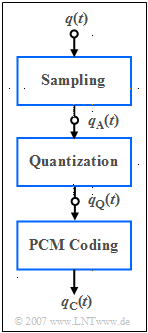Difference between revisions of "Aufgaben:Exercise 1.2Z: Puls Code Modulation"
From LNTwww
| Line 3: | Line 3: | ||
[[File:EN_Sig_Z_1_2.png|right|frame|Components of PCM]] | [[File:EN_Sig_Z_1_2.png|right|frame|Components of PCM]] | ||
| − | All modern communication systems are digital. The principle of digital transmission of speech signals goes back to [https://en.wikipedia.org/wiki/Alec_Reeves Alec Reeves] | + | All modern communication systems are digital. The principle of digital transmission of speech signals goes back to [https://en.wikipedia.org/wiki/Alec_Reeves Alec Reeves], who invented the so-called "Puls Code Modulation" $\rm (PCM)$ as early as 1938. |
On the right you see the (simplified) block diagram of the PCM transmitter with three functional units: | On the right you see the (simplified) block diagram of the PCM transmitter with three functional units: | ||
| Line 11: | Line 11: | ||
| − | In this task only the different signals of the PCM transmitter are to be classified. Later tasks will deal with other properties of | + | In this task only the different signals of the PCM transmitter are to be classified. <br>Later tasks will deal with other properties of the puls code modulation. |
| Line 18: | Line 18: | ||
| − | '' | + | ''Note:'' This task belongs to the chapter [[Signal_Representation/Signal_classification|Signal classification]]. |
| Line 37: | Line 37: | ||
- $q_{\rm A}(t)$ is a discrete-valued signal. | - $q_{\rm A}(t)$ is a discrete-valued signal. | ||
+ $q_{\rm A}(t)$ is a time-discrete signal. | + $q_{\rm A}(t)$ is a time-discrete signal. | ||
| − | + The higher the maximum frequency of the | + | + The higher the maximum frequency of the source signal, the higher the sampling rate must be selected. |
| Line 43: | Line 43: | ||
|type="[]"} | |type="[]"} | ||
+ $q_{\rm Q}(t)$ is a time-discrete signal. | + $q_{\rm Q}(t)$ is a time-discrete signal. | ||
| − | - $q_{\rm Q}(t)$ is a discrete-valued with | + | - $q_{\rm Q}(t)$ is a discrete-valued signal with $M = 8$ possible values. |
| − | + $q_{\rm Q}(t)$ is a discrete-valued with | + | + $q_{\rm Q}(t)$ is a discrete-valued signal with $M = 256$ possible values. |
- $q_{\rm Q}(t)$ is a binary signal. | - $q_{\rm Q}(t)$ is a binary signal. | ||
| − | {Which statements are true for the coded signal $q_{\rm C}(t)$ if $N = 8$ is taken as a | + | {Which statements are true for the coded signal $q_{\rm C}(t)$ if $N = 8$ is taken as a base? |
|type="[]"} | |type="[]"} | ||
+ $q_{\rm C}(t)$ is a time-discrete signal. | + $q_{\rm C}(t)$ is a time-discrete signal. | ||
Revision as of 13:24, 9 April 2021
All modern communication systems are digital. The principle of digital transmission of speech signals goes back to Alec Reeves, who invented the so-called "Puls Code Modulation" $\rm (PCM)$ as early as 1938.
On the right you see the (simplified) block diagram of the PCM transmitter with three functional units:
- The band-limited speech signal ${q(t)}$ is sampled, where the Sampling Theorem is observed, and yields the sampled signal $q_{\rm A}(t)$.
- Each sample $q_{\rm A}(t)$ is mapped to one of $M = 2^N$ results in the quantized signal $q_{\rm Q}(t)$.
- Each individual quantized value is represented by a code sequence of $N$ binary symbols and results in the coded signal $q_{\rm C}(t)$.
In this task only the different signals of the PCM transmitter are to be classified.
Later tasks will deal with other properties of the puls code modulation.
Note: This task belongs to the chapter Signal classification.
Questions
Solution
(1) Correct are the solutions 1, 2 and 4:
- The source signal ${q(t)}$ is analog, i.e. continuous in time and value.
- In general, it makes no sense to transmit a deterministic signal.
- For the mathematical description, a deterministic source signal – such as a periodic signal – is better suited than a random signal.
- Deterministic signals are also used for testing in order to be able to reconstruct detected errors.
(2) Correct are the solution suggestions 2 and 3:
- After sampling, the signal $q_{\rm A}(t)$ is still value-continuous, but now also time-discrete.
- The sampling frequency $f_{\rm A}$ is given by the so-called sampling theorem .
- The greater the maximum frequency $f_{\rm N,\,max}$ of the message signal, the greater must $f_{\rm A} ≥ 2 \cdot f_{\rm N,\,max}$ be selected.
(3) Correct are the solution suggestions 1 and 3:
- The quantized signal $q_{\rm Q}(t)$ is time and value discrete, where the number of steps are $M = 2^8 = 256$ .
- A binary signal, on the other hand, is a discrete value signal with the number of steps $M = 2$.
(4) Correct here are the solutions 1, 3 and 5:
- The coded signal $q_{\rm C}(t)$ is binary $($level number $M = 2)$ with bit duration $T_{\rm B} = T_{\rm A}/8$.
